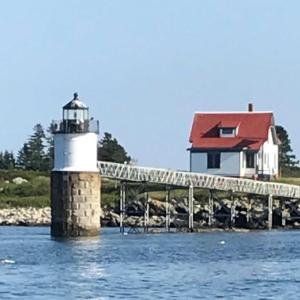Living on the brink: the life of a lighthouse keeper
 Ram Island lighthouse and keeper’s quarters. KELLIE BIGOS/Boothbay Register
Ram Island lighthouse and keeper’s quarters. KELLIE BIGOS/Boothbay Register
 Ram Island Lighthouse and walkway. KELLIE BIGOS/Boothbay Register
Ram Island Lighthouse and walkway. KELLIE BIGOS/Boothbay Register
 The passengers on Eastwind during a recent trip around Ram Island. KELLIE BIGOS/Boothbay Register
The passengers on Eastwind during a recent trip around Ram Island. KELLIE BIGOS/Boothbay Register
 A Fresnel lens from Ram Island on display at the Boothbay Region Historical Society museum. KELLIE BIGOS/Boothbay Register
A Fresnel lens from Ram Island on display at the Boothbay Region Historical Society museum. KELLIE BIGOS/Boothbay Register
 Ram Island keeper’s quarters. KELLIE BIGOS/Boothbay Register
Ram Island keeper’s quarters. KELLIE BIGOS/Boothbay Register
 Ram Island as seen from the Eastwind trip. KELLIE BIGOS/Boothbay Register
Ram Island as seen from the Eastwind trip. KELLIE BIGOS/Boothbay Register
 Ram Island lighthouse. KELLIE BIGOS/Boothbay Register
Ram Island lighthouse. KELLIE BIGOS/Boothbay Register
 Ram Island lighthouse and keeper’s quarters. KELLIE BIGOS/Boothbay Register
Ram Island lighthouse and keeper’s quarters. KELLIE BIGOS/Boothbay Register
 Ram Island lighthouse and keeper’s quarters. KELLIE BIGOS/Boothbay Register
Ram Island lighthouse and keeper’s quarters. KELLIE BIGOS/Boothbay Register
 Ram Island Lighthouse and walkway. KELLIE BIGOS/Boothbay Register
Ram Island Lighthouse and walkway. KELLIE BIGOS/Boothbay Register
 The passengers on Eastwind during a recent trip around Ram Island. KELLIE BIGOS/Boothbay Register
The passengers on Eastwind during a recent trip around Ram Island. KELLIE BIGOS/Boothbay Register
 A Fresnel lens from Ram Island on display at the Boothbay Region Historical Society museum. KELLIE BIGOS/Boothbay Register
A Fresnel lens from Ram Island on display at the Boothbay Region Historical Society museum. KELLIE BIGOS/Boothbay Register
 Ram Island keeper’s quarters. KELLIE BIGOS/Boothbay Register
Ram Island keeper’s quarters. KELLIE BIGOS/Boothbay Register
 Ram Island as seen from the Eastwind trip. KELLIE BIGOS/Boothbay Register
Ram Island as seen from the Eastwind trip. KELLIE BIGOS/Boothbay Register
 Ram Island lighthouse. KELLIE BIGOS/Boothbay Register
Ram Island lighthouse. KELLIE BIGOS/Boothbay Register
 Ram Island lighthouse and keeper’s quarters. KELLIE BIGOS/Boothbay Register
Ram Island lighthouse and keeper’s quarters. KELLIE BIGOS/Boothbay Register
I recently had the pleasure of sailing around Ram Island on the schooner Eastwind. As we rounded the island for a close-up look at the lighthouse, I heard someone onboard say, "That must have been a very boring job!"
I can understand how living on an island as a lighthouse keeper might sound like the most boring, lonely job imaginable. But if you think about it, lighthouse keepers were constantly living on the brink of disaster. And that can't be boring. Not keeping a light shining bright in a lighthouse on a dark and moonless night could spell shipwrecks, especially during howling storms when a battle against the elements is bad enough to begin with.
So I thought I'd look into some history on Ram Island.
The island is on the eastern side of the entrance to Boothbay Harbor and can be seen from Ocean Point in Boothbay. According to Malcolm Willoughby in his "Lighthouses of New England," in 1883 a lantern house was built on a granite foundation at the low water mark of the island. A wooden footbridge extended over the water for access. A lighthouse keeper's house was also built not far from the tower. Lighthouse keeper Samuel John Cavanor from Halifax, Nova Scotia had a wife named Mae. Eventually there were five daughters, Estelle, Wilhemina, Margaret, and twins Florence and Grace.
From the start, Samuel Cavanor battled disaster. As related in "Lighthouse Friends" by Kraig Anderson, during Cavanor's first winter, a fierce hail storm smashed the glass of the lantern and blew out the light. Cavanor stuffed newspapers over the broken pane so he could relight the lantern. In 1885, a storm swept away his station boat. A 1900 storm blew down the only three trees left on the island.
Hardly a year went by without at least one ship disaster in the area.
In his log, Cavanor wrote, on Dec. 6, 1884, the schooner Mineola ran aground on nearby Squirrel Island. In 1885, the schooner Garland was wrecked on the rocks called the Hypocrites.
Fresnel lenses, a type of compound lens developed in France by Augustin-Jean Fresnel to make lighthouse lanterns more effective, came into use in America in 1903. If one was in use in the lantern house the night of Jan. 18 of that year is uncertain. A heavy gale drove the schooner Harriet W. Babson onto Ram Island, smashing the connecting walkway to the lantern tower. She was laden with salt herring en route from Newfoundland to Gloucester, Massachusetts. As recorded in the Annual Report of the Operations of the U.S. Lifesavers Service, the ship was lost, but the whole crew safely reached shore and Cavanor provided them with food and shelter until they could be transported back home. The walkway was rebuilt.
Canavor's life was neither lonely nor boring. After his death, several other families manned the Ram Island Light until it became automated in 1965.
The Ram Island Light Station is preserved and under the stewardship of the Grand Banks Schooner Museum Trust and listed on the National Register of Historic Places. The Fresnel lens from the Ram Island Light Tower is now part of the collection of the Boothbay Region Historical Society.
Event Date
Address
United States




































